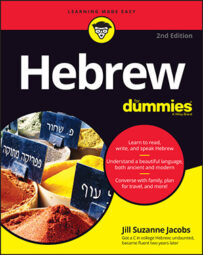Of course, when you buy clothes, you want to dress for the season. Whether you are wearing Begadim Yomiyim (beh-gah-deem yoh-mee-eem; casual clothes), Levush Chagigi (lah-voosh chah-gee-gee; dressy clothes), or even your Bigdei Shabbat(beeg-day shah-baht; Sabbath clothes, the Hebrew equivalent of "Sunday Best"), or if you live in a climate with four seasons, you want to have handy all kinds of clothes for the different weather.
Fall fashion
Ah, fall — when the air is crisp and the leaves are colorful! On the Jewish calendar, fall is the time of the High Holidays, including Rosh HaShanah and Yom Kippur — the Jewish New Year and the Day of Atonement. Fall is a time for new beginnings. It's also a great time to get some new clothes.
The following Hebrew words are a few fall items you may want to have on hand:
- Afudah (ah-foo-dah; vest)
- Me'il Katzar (meh-eel kah-tzar; jacket or short coat)
- Me'il-Geshem (meh-eel geh-shem; raincoat)
The winter look
Winter! What a magical time of year. If your home area receives snow, this time can be especially fun — and cold! Thus you need to bundle up. Following are some special items of winter clothing you may want to take out of storage when the temperatures start hovering around freezing:
- Kfafot (k-fah-foht; gloves)
- Kovah (koh-vah; hat)
- Magafayim (mah-gah-fye-eem; boots)
- Me'il (meh-eel; coat)
- Tza'if (tzah-eef; scarf)
Spring attire
Spring is wonderful! The days grow longer and warmer. Trees and flowers begin to bloom. And you can finally stop wearing those wool gloves and toss off that heavy coat in favor of a lighter jacket. You can now wear:
- Chultzah im Sharvulim K'tzarim (chool-tzah eem shahr-voo-leem keh-tzah-reem; short-sleeved shirt
- Mitria (mee-tree-yah; umbrella)
Summer wear
The dog days of summer! Long sunny days! Ice cream cones! And, of course, the clothes you can wear only on the hottest days of the year:
- Beged Yam (beh-gehdyahm; bathing suit)
- Michnahsayim K'tzarim (Mich-nah-sah-yeemKtzah-reem; shorts)
- Mishkafay-Shemesh (meesh-kah-fay Sheh-mesh; sunglasses)
- Sandalim (Sahn-dah-leem; sandals)
When you put two nouns together to form one word, you have a dependent relationship or a compound noun. In Hebrew, you call this compound a Smichut (smee-choot). A good example in English is the word "fireplace." Basically, two words combine to make up one word. In Hebrew, when both nouns are singular, putting them together in Smichut (smee-choot) is easy. For example, the word for swimsuit in Hebrew is Beged Yam (beh-gehd yahm), which means "sea suit." Note: In Hebrew, the order is the opposite as it is in English. In the previous example, Beged means clothes or suit while Yam means sea. So literally that means "clothing of the sea." Furthermore, if the nouns have only one syllable, their pronunciation remains the same. The one exception is the word for room Cheder (cheh-dair). In Smichut, Cheder (smee-choot, cheh-dair) becomes Chadar (chah-dar). Hence, the Hebrew word for "dressing room" is Chadar Halbashah (chah-dar hahl-bah-shah). If the first word in the Smichut is masculine plural, the final mem drops off. For example, sunglasses is Mishkafei Shemesh (meesh-kah-fey sheh-mesh). One more tidbit: If you want to add the word the (Hah; hah) to a Smichut, put it in front of the second noun.
For example:
- Beged HaYam (beh-gehd hah-yahm; the bathing suit)
- Chadar Ha'Halbashah (chah-dar hah-hahl-bah-shah; the dressing room)
- Mishkafei HaShemesh (meesh-kah-fey hah-sheh-mesh; the sunglasses)

